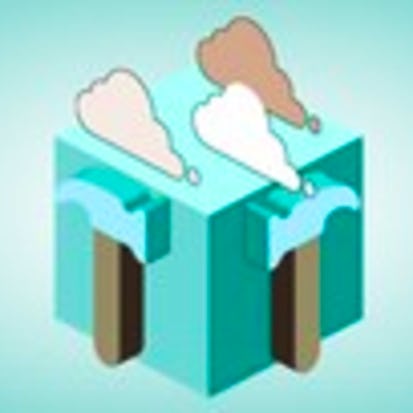- Level Foundation
- المدة 20 ساعات hours
- الطبع بواسطة University of Illinois Urbana-Champaign
-
Offered by

عن
Welcome to the Cloud Computing Applications course, the second part of a two-course series designed to give you a comprehensive view on the world of Cloud Computing and Big Data! In this second course we continue Cloud Computing Applications by exploring how the Cloud opens up data analytics of huge volumes of data that are static or streamed at high velocity and represent an enormous variety of information. Cloud applications and data analytics represent a disruptive change in the ways that society is informed by, and uses information. We start the first week by introducing some major systems for data analysis including Spark and the major frameworks and distributions of analytics applications including Hortonworks, Cloudera, and MapR. By the middle of week one we introduce the HDFS distributed and robust file system that is used in many applications like Hadoop and finish week one by exploring the powerful MapReduce programming model and how distributed operating systems like YARN and Mesos support a flexible and scalable environment for Big Data analytics. In week two, our course introduces large scale data storage and the difficulties and problems of consensus in enormous stores that use quantities of processors, memories and disks. We discuss eventual consistency, ACID, and BASE and the consensus algorithms used in data centers including Paxos and Zookeeper. Our course presents Distributed Key-Value Stores and in memory databases like Redis used in data centers for performance. Next we present NOSQL Databases. We visit HBase, the scalable, low latency database that supports database operations in applications that use Hadoop. Then again we show how Spark SQL can program SQL queries on huge data. We finish up week two with a presentation on Distributed Publish/Subscribe systems using Kafka, a distributed log messaging system that is finding wide use in connecting Big Data and streaming applications together to form complex systems. Week three moves to fast data real-time streaming and introduces Storm technology that is used widely in industries such as Yahoo. We continue with Spark Streaming, Lambda and Kappa architectures, and a presentation of the Streaming Ecosystem. Week four focuses on Graph Processing, Machine Learning, and Deep Learning. We introduce the ideas of graph processing and present Pregel, Giraph, and Spark GraphX. Then we move to machine learning with examples from Mahout and Spark. Kmeans, Naive Bayes, and fpm are given as examples. Spark ML and Mllib continue the theme of programmability and application construction. The last topic we cover in week four introduces Deep Learning technologies including Theano, Tensor Flow, CNTK, MXnet, and Caffe on Spark.الوحدات
About the Course
1
Assignment
- Orientation Quiz
1
Videos
- Welcome to Cloud Applications, Part 2!
2
Readings
- Syllabus
- About the Discussion Forums
About Your Classmates
1
Discussions
- Getting to Know Your Classmates
2
Readings
- Updating Your Profile
- Social Media
Module 1 Information
1
Readings
- Module 1 Overview
Lesson 1.1: Spark
7
Videos
- 1.1.1 Motivation for Spark
- 1.1.2 Apache Spark
- 1.1.3 Spark Example: Log Mining
- 1.1.4 Spark Example: Logistic Regression
- 1.1.5 RDD Fault Tolerance
- 1.1.6 Interactive Spark
- 1.1.7 Spark Implementation
Lesson 1.2: Big Data Distros
4
Videos
- 1.2.1 Introduction to Distros
- 1.2.2 Hortonworks
- 1.2.3 Cloudera CDH
- 1.2.4 MapR Distro
Lesson 1.3: HDFS
2
Videos
- 1.3.1 HDFS Introduction
- 1.3.2 YARN and MESOS
Module 1 Graded Activities
1
Assignment
- Module 1 Quiz
Module 2 Information
1
Videos
- Module 2 Introduction
1
Readings
- Module 2 Overview
Lesson 2.1: MapReduce
7
Videos
- 2.1.1 Introduction to MapReduce with Spark
- 2.1.2 MapReduce: Motivation
- 2.1.3 MapReduce Programming Model with Spark
- 2.1.4 MapReduce Example: Word Count
- 2.1.5 MapReduce Example: Pi Estimation & Image Smoothing
- 2.1.6 MapReduce Example: Page Rank
- 2.1.7 MapReduce Summary
Lesson 2.2: CAP Theorem & Eventual Consistency
7
Videos
- 2.2.1 Eventual Consistency – Part 1
- 2.2.2 Eventual Consistency – Part 2
- 2.2.3 Consistency Trade-Offs
- 2.2.4 ACID and BASE
- 2.2.5 Zookeeper and Paxos: Introduction
- 2.2.6 Paxos
- 2.2.7 Zookeeper
Lesson 2.3: Distributed Key-Value Store
3
Videos
- 2.3.1 Cassandra Introduction
- 2.3.2 Redis
- 2.3.3 Redis Demonstration
2.4: Scalable Databases
5
Videos
- 2.4.1 HBase Usage API
- 2.4.2 HBase Internals - Part 1
- 2.4.3 HBase Internals - Part 2
- 2.4.4 Spark SQL
- 2.5.5 Spark SQL Demo
Lesson 2.5: Publish - Subscribe Queues
1
Videos
- 2.5.1 Kafka
Module 2 Graded Activities
1
Assignment
- Module 2 Quiz
Module 3 Information
1
Videos
- Module 3 Introduction
1
Readings
- Module 3 Overview
Lesson 3.1: Streaming
6
Videos
- 3.1.1 Streaming Introduction
- 3.1.2 "Big Data Pipelines: The Rise of Real-Time"
- 3.1.3 Storm Introduction: Protocol Buffers & Thrift
- 3.1.4 A Storm Word Count Example
- 3.1.5 Writing the Storm Word Count Example
- 3.1.6 Storm Usage at Yahoo
Lesson 3.2: Advanced Storm
2
Videos
- 3.2.1 Anchoring and Spout Replay
- 3.2.2 Trident: Exactly Once Processing
Lesson 3.3: Storm Internals
6
Videos
- 3.3.1 Inside Apache Storm
- 3.3.2 The Structure of a Storm Cluster
- 3.3.3 Using Thrift in Storm
- 3.3.4 How Storm Schedulers Work
- 3.3.5 Scaling Storm to 4000 Nodes
- 3.3.6 Q&A with Bobby Evans (Yahoo) on Storm
Lesson 3.4: Spark Streaming
3
Videos
- 3.4.1 Spark Streaming
- 3.4.2 Lambda and Kappa Architecture
- 3.4.3 Streaming Ecosystem
Module 3 Graded Activities
1
Quiz
- Module 3 Quiz
Module 4 Information
1
Readings
- Module 4 Overview
Lesson 4.1: Graph Processing
7
Videos
- 4.1.1 Graph Processing
- 4.1.2 Pregel - Part 1
- 4.1.3 Pregel - Part 2
- 4.1.4 Pregel - Part 3
- 4.1.5 Giraph Introduction
- 4.1.6 Giraph Example
- 4.1.7 Spark GraphX
Lesson 4.2: Machine Learning
10
Videos
- 4.2.1 Big Data Machine Learning Introduction
- 4.2.2 Mahout: Introduction
- 4.2.3 Mahout kmeans
- 4.2.4 Mahout: Naïve Bayes
- 4.2.5 Mahout: fpm
- 4.2.6 Spark Naïve Bayes
- 4.2.7 Spark fpm
- 4.2.8 Spark ML/MLlib
- 4.2.9 Introduction to Deep Learning
- 4.2.10 Deep Neural Network Systems
Lesson 4.3: Closing Remarks
1
Videos
- 4.3.1 Closing Remarks
Module 4 Graded Activities
1
Assignment
- Module 4 Quiz
1
Discussions
- Final Reflections
Auto Summary
Dive into Cloud Computing Applications, Part 2: Big Data and Applications in the Cloud with Coursera. This IT & Computer Science course, led by expert instructors, delves into advanced cloud data analytics and big data technologies like Spark, Hadoop, HDFS, and Kafka. Over four weeks, explore distributed systems, real-time streaming, machine learning, and deep learning. Ideal for foundational learners, with flexible subscription options: Starter, Professional, and Paid. Enhance your skills in a rapidly evolving field.

Reza Farivar

Roy H. Campbell


